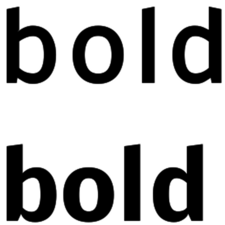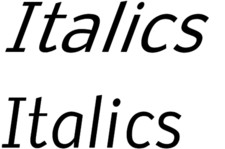LibreOffice: how to avoid manufactured font weights

Off the Beat: Bruce Byfield's Blog
LibreOffice does it. Calligra Suite and Abiword do, too. In fact almost all the word processors you ever used will manufacture bold and italic weights as well as small caps when no font metrics are available. Fortunately, you can work around this over-helpfulness, but you have to be aware of what is happening.
For reasons still unclear to me, LibreOffice varies in its detection of font files. It is not, as I first thought, simply a question of whether font metrics for different weights are stored in one file or several. However, I do know that if you have different weights installed but the toolbar's list of fonts gives only the family name, nothing should be manufactured. By contrast, if the files for some weights are missing, or the weights have separate entries in the font list, then bold and italic weights are manufactured.
As for small capitals, they are usually manufactured whenever small capitals are not included in the font. In the past, I have sometimes seen small caps as a separate entry in the font list, but that seems to have disappeared in recent releases. If small caps are still listed separately for any font, then LibreOffice would presumably manufacture small caps instead of using the real ones.
What's wrong with manufactured fonts?
At first, manufactured weights might seem a benefit. Surely, you might say, they are better than not having the weights available at all?
However, there are at least two reasons for avoiding the use of manufactured fonts.
First, manufactured fonts mean that users are not seeing the font as the designer intended. Font design may be a minor art form, but distorting the design of a font is similar to placing a painting of Van Gogh in a dark corner where his perception of light is hidden by the dimness, or using Auto-Tune in a recording of a singer with a four octave vocal range. If you like a font well enough to use it, you should at least treat its designs with respect.
Most important of all, however, is that manufactured results are almost always a mess. Thickness of character, letter shape, and spacing are jarringly irregular.
Figure 1, for example, shows examples of a manufactured bold weight for the free-licensed font Nobile. The manufactured weight at the top shows none of the subtlety of design of the true bold weight for Nobile, shown at the bottom. The manufactured weight cannot even get the angle right at the top of the "b" and the "d."
Figure 1
Even worse is the manufactured Nobile Italic weight at the top of figure 2. It not only gets the lower case "a" completely wrong, but the angle of the italic is extreme enough to cause reading problems. In fact, I consider the manufactured italic unusable.
Figure 2
However, by far the worst example is the manufactured small capitals in figure 3. They look nothing like the true small caps -- in fact, they could almost be regular capitals by their size, and are hardly worth using.
Figure 3
These examples are all created using LibreOffice. Abiword and Calligra Suite give different results for manufactured weights, but none are significantly better or worse than the ones shown.
What digital typography obscures is that changing the weight of a font is not as easy as a click of the button. In pre-computer typography, even the change in the size of a font was seen as reason to adjust the proportions of individual characters, and adjusting a weight was that much more complicated. Such adjustments are as much an art as a science, and the ability to manufacture different weights would have to be much more sophisticated than it has ever been in any word processor to produce adequate manufactured fonts in even most circumstances. At the very least, the challenge is complicated enough that no one has ever tackled it.
Avoiding manufactured fonts
Anyone who respects artists and cares about the look of their documents should avoid manufactured fonts at all costs. When designing a document, check whether your chosen faults have entries for different weights in LibreOffice's font list.
If they do, avoid creating different weights from the toolbar icons or the Character dialogue window, regardless of whether you are using manual or stylistic formatting.
Instead, create separate character styles for each weight you use. You can create your own styles, or use Emphasis for italics, Strong Emphasis for bold, and Placeholder for small caps. If you always use these character styles, and never change weights from the Regular or Roman version of the font, then manufactured weights should never haunt you.
Follow these guidelines, and manufactured fonts will never create design problems for you. You can forget these relics, consigning them to the oblivion that they deserve.
comments powered by DisqusSubscribe to our Linux Newsletters
Find Linux and Open Source Jobs
Subscribe to our ADMIN Newsletters
Support Our Work
Linux Magazine content is made possible with support from readers like you. Please consider contributing when you’ve found an article to be beneficial.

News
-
Fedora 43 Has Finally Landed
The Fedora Linux developers have announced their latest release, Fedora 43.
-
KDE Unleashes Plasma 6.5
The Plasma 6.5 desktop environment is now available with new features, improvements, and the usual bug fixes.
-
Xubuntu Site Possibly Hacked
It appears that the Xubuntu site was hacked and briefly served up a malicious ZIP file from its download page.
-
LMDE 7 Now Available
Linux Mint Debian Edition, version 7, has been officially released and is based on upstream Debian.
-
Linux Kernel 6.16 Reaches EOL
Linux kernel 6.16 has reached its end of life, which means you'll need to upgrade to the next stable release, Linux kernel 6.17.
-
Amazon Ditches Android for a Linux-Based OS
Amazon has migrated from Android to the Linux-based Vega OS for its Fire TV.
-
Cairo Dock 3.6 Now Available for More Compositors
If you're a fan of third-party desktop docks, then the latest release of Cairo Dock with Wayland support is for you.
-
System76 Unleashes Pop!_OS 24.04 Beta
System76's first beta of Pop!_OS 24.04 is an impressive feat.
-
Linux Kernel 6.17 is Available
Linus Torvalds has announced that the latest kernel has been released with plenty of core improvements and even more hardware support.
-
Kali Linux 2025.3 Released with New Hacking Tools
If you're a Kali Linux fan, you'll be glad to know that the third release of this famous pen-testing distribution is now available with updates for key components.



